From the Archives: Choirs, Cantors and Organs
From the Archives: Choirs, Cantors and Organs
By Susan Cohen

Collection of Religious and Popular Israelite Songs, with historical essay by composer Samuel Naumbourg; published 1874, found in Holy Blossom Music Archives
You can explore Holy Blossom’s archives through many lenses such as people, events, liturgy, or social action. Michael Cole and I have been reviewing musical archives prior to sending Cantor Emeritus Benjamin Maissner’s musical material to libraries in Israel and Germany.
It took 70 years to firmly establish the role of cantor at our synagogue. Our first ‘cantor’ (in 1879), Joseph Glueck may have been the first musically trained chazzan in Toronto, but he was also a teacher, baal koray, shochet, mohel and dues collector. No wonder he only lasted 3 years.
As the synagogue grew, the leadership looked for more distinguished clergy. Reverend Herman Phillips, a well-regarded and trained cantor from Europe, joined us next. Blessed with a rich baritone, he fulfilled the roles of teacher and spiritual leader as well as cantor. But music became a bone of contention between the orthodox and reformist wings of the synagogue. Feelings reached such a pitch in 1890 that dissident congregants dumped the synagogue’s portable organ outside and the board demanded its return. The use of the organ made Cantor Phillips resign, and a rabbi was hired that year who was not averse to the instrument.
Four years later the synagogue created a separate cantor’s position, filled by Cantor Sol Solomon. He came from Paris, the Rue de Nazareth synagogue, famed as the musical home of Samuel Naumbourg whose compositions we still sing today. Solomon likely brought Naumbourg’s choral and organ works to sing here; we have found some music books of that era in the archives. Entirely in keeping with Cantor Solomon’s background, our new synagogue on Bond St. (1897) made room for a permanent pipe organ and choir loft. Emma Yoemans took on the role of organist.
Cantor Solomon’s position was never entirely secure and he left in 1901. In letters we have in our archives, he told Holy Blossom President Alfred Benjamin that the synagogue had not treated him well nor was he appropriately compensated. There was even some dispute about whether he had properly taken music with him. Jewish newspapers of the time said that Holy Blossom could not afford both a cantor and a rabbi.
From 1901 until 1943 the synagogue employed no cantor at all, a not-unusual feature of Reform synagogues of the time. When our Bathurst St. building opened in 1938, there was space for a choir and organ, but none for a cantor, not even a cantor’s lectern. Still, the choir had many talented professionals in it, and some took on chazzan-like roles including Sam Stolnitz. He had been taught cantorial skills by his father and was a gifted singer formally trained at the Toronto Conservatory. In 1949 Rabbi Abraham Feinberg told the board that Stolnitz would share the “chancel” with him at services. We have been served by exceptional cantors ever since.
You may wish to visit the Archives Committee displays at the far end of the Temple Atrium honouring Rabbi Marmur z”l and The Pioneering Women of Holy Blossom, as well as the Living Museum in the Atrium by the elevator.
If you have any items of archival interest to contribute to the Holy Blossom archives, we would love to hear from you. Please email us at archives@holyblossom.org.





Leave a Reply
Want to join the discussion?Feel free to contribute!